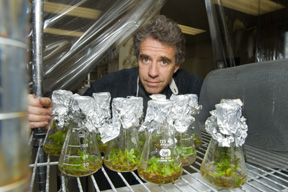Vegetarian Ferns? Idaho State University researchers note simple plant species ‘consumes sugar’
June 12, 2009
In a significant scientific paper soon to be published in the well respected journal Botany, Idaho State University researchers have documented how ferns, a primitive plant, “consume” sugars in early life stages.
“Ferns and their plant allies are very primitive plants that reproduce without seeds,” said Jeff Hill, ISU associate professor of biological sciences. “Sugar uptake from their environment during a microscopic phase of their life cycle is a potentially important part of their ecology. What we think is that ferns have the ability to pick up simple sugars from the soils when they germinate.”
 This challenges the basic beliefs that many have towards plants in general and opens the door for a wide range of new research on this topic.
This challenges the basic beliefs that many have towards plants in general and opens the door for a wide range of new research on this topic.
Plants are generally thought of as self-feeders, which produce food for themselves through photosynthesis by processing light and inorganic materials. Scientists have long known that some plants, such as pitcher plants, are carnivorous and gain nitrogen and carbon nutrients by consuming insects. However, it has not been widely thought that plants uptake sugar from their environment for nourishment.
“The broad view of plants is that they are self-feeders, that by using photosynthesis they produce their own food and don’t have to go to the ‘refrigerator’ and they fix carbon from the air to eventually produce sugars,” Hill said. “We’re on the cusp of learning that, as an important part of their ecology, some plants in certain habitats have the ability to supplement and augment their photosynthetic ability by essentially grabbing free sugar from their environment.”
Hill credits much of this new knowledge to former ISU biological sciences doctoral student Deborah A. Alongi, who worked on this topic for her dissertation with Hill and ISU biological sciences professor Mike Thomas as her advisors. They also worked with Matt Germino, ISU associate professor of plant physiological ecology, who runs Idaho State University’s Plant Physiology Laboratory.

Alongi, who currently is completing post-doctoral work at the University of Sheffield in Sheffield, United Kingdom, summed up the most important aspects of the study by saying, “Uptake of sugar from the environment may help explain how fern gametophytes, which appear to be fragile, may actually be the phase of the fern life cycle which is most able to survive harsh environmental conditions.”
The title of the ISU researchers’ paper that documents this phenomenon is “Opportunistic heterotrophy in gametophytes of the homosporous fern Ceratopteris richardii.” It is co-authored by Alongi, Hill and Germino.
Scientists have known since at least the 1950s that gametophytes, the tiny plants that become the larger ferns that most people are more familiar with, grow well when the plants are grown in the presence of sugar. However, no one, according to the ISU researchers, tried to confirm the way the sugar was going into the plant, and, “moreover didn’t think about what it means that a plant takes sugar out of the soil and actually uses it to grow,” noted Hill.
The ISU researchers theorize that ferns, which can often be forced to grow in very low-light conditions depending on where spores land, supplement their ability to produce sugars by photosynthesis by absorbing small amounts of sugar from soil. Small amounts of sugar get into the soil from decomposing plants and microbes.
“The ability to nourish themselves in two different ways makes them wonderfully adaptive,” Germino said.
In the primary study, Alongi grew tiny fern gametophytes in flasks with different levels of sugar and different light levels and measured the depletion of sugar in the solution around the gametophytes. The researchers found that as the gametophytes received more light they used less sugar, and too much light could actually damage the organisms.
“Her observations basically provide the first concrete evidence that sugar is moving from the environment into the plant, and that additional sugar is changing the developmental path,” Hill said. “Sugar is indeed being taken up and the plant is clearly using it for growth.”
Alongi also studied genes known to be “turned on” in germinating gametophytes, and documented that the ferns do express genes that provide the ability to transfer sugar from their environment. The ISU researchers also documented that fern gametophytes have the ability to break down complex sugars into fructose or glucose, with initial studies indicating the ferns prefer importing the fructose.
“An important aspect of this study is that we have found that ferns and probably related fern allies might be using sugars significantly for their survival,” Hill said.
Alongi noted that sugars not only provide energy for growth in plants and all other organisms, but they are now known to act as signals to change the expression of many other genes, potentially altering development and physiology in response to the availability of energy.
Future study of the role of sugar in growth and development will be greatly enhanced by new genome sequencing technology, where genes "turned up" or "turned down" by the presence of sugar in the environment can be identified and measured.
“We are currently in the early planning stages of designing future research projects to study the role of sugar levels on plant growth, survival and development, both in ferns and in higher plants,” Alongi said.
Categories:
